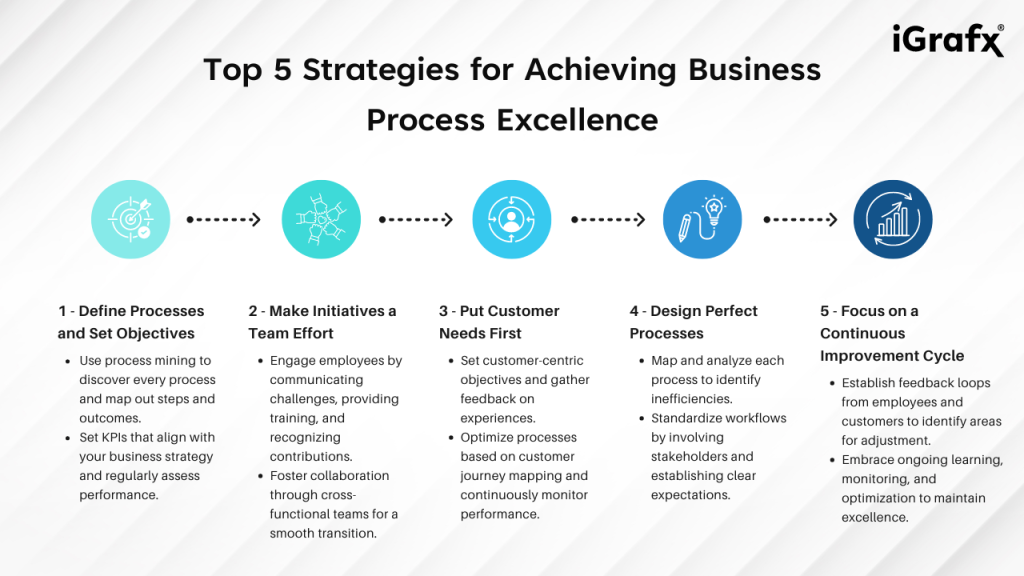All companies want to achieve growth, but what happens when that growth comes at a price? Your products are superior, you have a great team, and you have an ambitious business plan. It’s easy to focus on immediate success, but the higher your company reaches, the more it seems to forget.
From unpaid invoices to unhappy customers and disengaged employees, a company’s rise can be rapidly followed by a plummet back to earth.
So, how do you achieve growth without sacrificing consistency and customer satisfaction?
The answer is simple: business process excellence.
What is process excellence?
Process excellence is a systematic approach to achieving optimal performance by aligning people, processes, and technology. It’s a continuous cycle of identifying, analyzing, and redesigning business processes to deliver exceptional value to customers while maximizing efficiency and effectiveness.
Can my business achieve process excellence?
Absolutely. Any organization can create a culture of process improvement and achieve excellence by constantly evaluating and optimizing processes. Technology means you don’t need a huge budget or extensive resources; implementing the right solution will result in sustainable growth.
Ready to discover five top strategies for achieving process excellence?
Let’s get straight to it.
1: Define processes and set objectives
Simply put, organizations can’t achieve excellence without understanding their current processes. The first step is to use process mining, which uses data to discover every process and the steps within them.
Next, you’ll create a visual representation of each process, including the end-to-end steps and outcomes, also known as process mapping. For example, you could map how long it takes the customer to find resolutions through your support channels or the time it takes to create a product.
Both process mining and mapping can help organizations achieve operational excellence by identifying and eliminating inefficient workflows.
Setting KPIs
Business process management is never stagnant; it’s a cycle of adaptation and evolution. Setting process excellence goals means regularly assessing which workflows are performing as desired, and when they’re not, eliminating bottlenecks as they arise.
When setting benchmarks for your process strategy, remember the following factors:
- Your Business Strategy: What are your long-term objectives? Do your current processes align with these goals?
- Gap Analysis: What’s the gap between your current and desired processes? Why aren’t you achieving process excellence?
- SMART Goals: Specific, measurable, achievable, realistic, and time-bound goals keep you on track and provide the foundations for a business process excellence strategy.
- Set Priorities: Consider how each goal aligns with your far-reaching organizational priorities and liaise with stakeholders.
- Develop KPIs: Set KPIs that enable you to measure them regularly. For example, “increase order fulfillment by 25%”.
2: Make process excellence initiatives a team effort
Process excellence is only achievable with committed and passionate employees. The days of working for a paycheck are long gone, and every business knows that an engaged workforce unlocks long-term success.
A study published by the Harvard Business Review found that employees find being ignored and kept out of the loop more psychologically harmful than dealing with harassment.
Getting senior management involved in implementing a business process excellence framework is just one piece of the puzzle, as the employees will play integral roles in implementing the changes.
Inspire employees by:
- Communicating: Clearly outline the challenges of existing processes and explain how a culture of process improvement will transform the company.
- Training: All employees should receive ongoing training that helps them adapt and engage with new processes.
- Recognition: Recognizing and rewarding employee involvement and contributions is vital to process improvement. Research shows that 46% of employees would leave their jobs if they didn’t feel appreciated (Forbes).
- Collaboration: Many internal processes will require a cross-departmental approach. Creating cross-functional teams ensures a smooth transition.
3: Put customer needs first
It seems like a no-brainer, but many organizations focus on the continuous improvement of internal processes and forget about external operations. Whether you sell products or services, each process should be streamlined for maximum efficiency.
According to Khoros, 65% of people with a poor customer experience will switch loyalties to a different brand. Process excellence is about exceeding customer expectations and designing each workflow with your audience’s needs in mind.
Here’s how to integrate customers into your strategy:
Set customer-centric objectives
Gather customer feedback about previous experiences, including website experiences, order processing times, and support. Process mining can also play a role here. By automatically mining the data associated with customer experiences, you can easily identify inefficiencies and delays. Once you know where your processes are lacking, you can set goals and KPIs to improve satisfaction rates.
Emphasize and optimize
Mapping the customer journey enables you to isolate critical touchpoints and examine delays in the current process. Organizations achieve process excellence by listening to their customers, optimizing processes for experience, and emphasizing the importance of each workflow to internal stakeholders.
Monitor your processes
Process excellence focuses on constant evaluation and adaptation. Setting benchmarks for new processes and continuously assessing them enables you to improve performance and discover new ways to give customers the best possible experience.
4: Design perfect processes
In most areas of life and work, total perfection doesn’t exist—but that’s not the case with business process management. You CAN achieve perfect processes, but it takes time, effort, and dedication. The following steps are integral to perfecting existing workflows:
Map and analyze each process
Create a visual representation of each step in a process and identify inefficiencies. You can measure each process against set benchmarks for efficiency, compliance, and experience.
In the past, process auditing required manual intervention, but technology has paved the way for a range of advanced solutions that perform automatic process mining and mapping and deliver key insights.
Identify and eliminate
Identify which processes require optimization and eliminate waste by analyzing each step. For example, if an organization spends a lot of time on manual invoicing, you can adopt new software and automate the process, which preserves resources.
We’ll cover how to redesign, simulate, and automate processes in the next section.
Standardize processes
When changing an existing process or implementing a new one, involving all stakeholders and standardizing the workflow is essential. Establishing guidelines and setting clear expectations ensures accountability and inspires employees to embrace the changes.
5: Focus on a continuous improvement cycle
You’ll never be able to achieve business excellence unless you adopt a changed-focused attitude. Process management isn’t a one-time thing; it requires continuous learning, monitoring, and optimization.
Establishing feedback loops from employees and customers can help you identify whether the new processes are working. If not, they require further adjustments to achieve maximum efficiency.
Continuous process improvement can be challenging, but ensuring employees understand the value of these efforts – along with new process management technology will lead to organizational success.
Key techniques and tools for achieving process excellence
Due to technological advances, process management techniques have evolved significantly in recent years. Artificial intelligence and machine learning mean anyone can focus on their processes without requiring extensive resources.
Understanding which process excellence techniques to use for each stage of the journey will give your organization a competitive advantage.
Process mapping
We briefly explored process mapping, but it’s wise to mention it again, as this is often the first step in achieving excellence. When you create a visual representation of each step within a process, it’s easier to identify unnecessary steps by evaluating inputs and outputs.
For example, if you spend a lot of time and money on recruitment but your employees aren’t meeting performance targets, implementing a training program can increase profitability.
Mapping processes identifies and removes bottlenecks.
Lean management practice
Manufacturing businesses or those with supply chains should also consider exploring lean methodology. Lean management is about identifying and removing an organization’s waste, enabling it to maintain quality and provide customers with a better experience.
While traditional lean methodology isn’t a part of business process excellence, it’s a beneficial strategy for eliminating waste and speeding up productivity.
Total Quality Management
TQM is a strategic approach to improve quality across an organization. It can only be effective if all members contribute and work towards the same goals, including improving products, services, customer satisfaction rates, and workplace culture.
Establishing core quality control guidelines and defining ways to improve quality is vital to the technique, and organizations that don’t have strong relationships with their employees might struggle to implement Total Quality Management principles.
Business process reengineering
Business process reengineering involves redesigning processes to achieve excellence. It’s a key component of BPM, as it eliminates bottlenecks within each workflow and uses technological innovations to assess the potential outcomes of new processes.
Using process simulation tools means companies don’t need to worry about risks. Implementing new processes in a live environment could prove costly, but simulation tools let you see whether the new workflow will deliver its desired results.
Balanced scorecards
You can’t achieve process excellence unless you have set metrics for measuring performance. A balanced scorecard diversifies your company’s far-reaching mission and objectives, splitting it into four perspectives that highlight growth and success:
- Financial: ROI, profit margins, and revenue growth.
- Customers: Retention rates, positive reviews, and market share.
- Internal: Operational efficiency, production times, and quality.
- Learning and Growth: Employee turnover rates, satisfaction, productivity, and training hours.
Gemba walks
It’s challenging for senior managers to implement process excellence initiatives without seeing how employees are performing. Gemba walks ensure managers regularly visit the workplace to assess processes and isolate areas for improvement.
It’s also an opportunity to engage with lower-level workers, asking them about their opinions. This not only supports process improvement initiatives but also lets employees know that they’re valued members of the organization.
Process excellence tools
Thanks to the range of tools available, integrating process improvement methodologies into your organization is easier today than ever before. Whether you need to identify workflows, automate tasks, or assess process performance, these tools will save you time and money.
Flowcharts
Flowcharts are easy to use and provide visual evidence of the steps within a process. They highlight the outcomes of each process and isolate bottlenecks, making it easier to optimize workflows. Flowcharts can be used for simple and complex processes.
SWOT analysis
Most managers use the SWOT framework to gather insights when evaluating business operations. Knowing your organization’s strengths, weaknesses, opportunities, and threats provides a clear overview of internal and external positions.
BPM software
Business process management incorporates Six Sigma, process mining, mapping, simulation, automation, and optimization, making it a powerful solution for organizations. Integrating end-to-end business process management software means you can manage everyone in one place.
Performance management software
Integrating a powerful performance management system is essential if you want to empower your employees and create an efficient work environment. These tools monitor performance, offer feedback, and isolate skills and weaknesses.
Business process automation
One powerful way to achieve cost reduction across your company is through automation. For example, HRD America reports that employees waste two hours daily searching for documents, people, or information to do their jobs. When you automate manual tasks, you save time and enhance productivity.
Key takeaways:
- Business process excellence offers a range of benefits, including increases in efficiency, quality, productivity, and customer satisfaction. It can also give your organization a competitive advantage, enabling it to grow and scale in line with industry trends and evolving consumer demands.
- Following the five strategies we mentioned in this guide means you can lay the foundations for ongoing improvements and prime each process for optimal performance.
- Integrating software solutions into your process management strategy can preserve resources, highlight all steps within a process, and simulate new workflows. Most importantly, it removes room for errors and catapults your company into the future.
- Never approach process management as a one-time task. The only way to achieve your objectives is through continuous process excellence. Constantly evaluate your results and be ready to run different simulations to assess their potential impact.
Supercharge your organization’s processes with Process360 Live
Establishing and securing an operational excellence framework is complex, with multiple software solutions attempting to work together. We created Process360 Live to provide our customers with an end-to-end BPM solution.
From process mining to simulation and monitoring, you can take advantage of the ultimate strategic management tool.
Whether you want to improve internal operations, implement operational excellence initiatives, or provide customers with a seamless experience, Process360 Live integrates into your business.
Please begin your free trial or book a demo and see the software in action.


